Butter Dishes - Part I
by Mark A. Nye
Issue No. 166 - February 1987
During its first years of existence, the Cambridge Glass Company produced, among other things, an extensive line of imitation cut glass under the trademark "Nearcut." Cambridge was not unique in this endeavor as most, if not all, major glass houses of the time also produced similar imitation cut glass. These lines were aimed at the population segment unable to afford the brilliant cut glass so popular during those years. The Cambridge lines ranged from those with only a few pieces to extensive patterns with a multitude of items, including a wide variety of butter dishes.
Beginning in the 1920s, the style of American glassware changed from heavy pressed goods, of which imitation cut was a part, to a lighter appearing ware. The Cambridge Glass Company, observing the trend, followed suit, a smart move if they wanted to continue to be a prosperous concern, as obviously Mr. Bennett did. In the process of doing so, intentionally or unintentionally, many lines brought out after the mid-1920s failed to include a butter dish. The reason behind this absence is one we will probably never learn.
Prominent lines from the late 1920s, 1930s, 1940s and later that did not include a butter dish were: Decagon, Tally-Ho, Gadroon, Pristine, Caprice, Martha, Victorian (Martha Washington), Cascade, Cambridge Square, and the somewhat less familiar Virginian line. Several of these were long running and very popular lines, thus the absence of a butter dish is somewhat puzzling in light of the fact that except for a butter dish they were rather complete dinner and tableware lines. The Caprice line finally acquired a butter dish shortly before the plant closing in 1954, however the others never did.
There was not a complete absence of butter dishes in the Cambridge catalog during this period however. A few different styles were being made and these saw wide usage in color and crystal, plain and decorated.
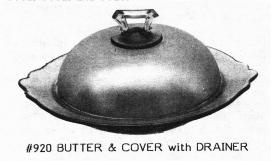 The recently reprinted 1927-29 Cambridge catalog contains an
illustration of the Round Line #920 3-piece butter dish. In addition to
the bottom and cover, there is a liner on which the butter actually
sits. No information regarding the use of this butter as a blank for
etched lines during the 1920s is provided in this catalog nor does the
1930 catalog provide such data even though it again is shown plain.
Without a doubt, on this butter dish will be found such 1920s and 1930s
etchings as #704, #731, #732 and #520.
The recently reprinted 1927-29 Cambridge catalog contains an
illustration of the Round Line #920 3-piece butter dish. In addition to
the bottom and cover, there is a liner on which the butter actually
sits. No information regarding the use of this butter as a blank for
etched lines during the 1920s is provided in this catalog nor does the
1930 catalog provide such data even though it again is shown plain.
Without a doubt, on this butter dish will be found such 1920s and 1930s
etchings as #704, #731, #732 and #520.
Specific color information remains lacking, but the #920 butter dish has been seen in amber, peach-blo and emerald (light) green. It was probably produced in most, if not all, of the prominent colors of the late 1920s and 1930s. Etched ware will be in both color and crystal.
Possibly the best known Cambridge butter dish is the #3400/52. First
seen in 1930 as a part of the #3400 Line, this butter was described by
Cambridge as a 5½" Butter and Cover. 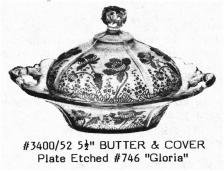 The #3400/52 butter dish
was to remain in the Cambridge line for the next twenty-four years,
only to be discontinued with the initial plant closing in 1954.
The #3400/52 butter dish
was to remain in the Cambridge line for the next twenty-four years,
only to be discontinued with the initial plant closing in 1954.
The #3400/52 butter dish made two appearances in the 1930 catalog, one etched Apple Blossom and the other etched Gloria. While not shown with any of the other etchings then available, it is highly likely such patterns as Portia and Diane came with a butter dish during this period.
While not shown in the 1930 catalog with rock crystal engravings, this #3400/52 butter dish has been seen decorated with cuttings.
Regarding color production during the 1930s, I once again make use of the information found on the page titled "General Information" in the 1930 catalog.
"Refer to Price List for COLORS in which Glassware shown in this catalog is made. Practically all items illustrated are made in Crystal, as well as the prevailing transparent colors, such as Amber, Emerald, Peach-Blo, Willow-Blue and Gold Krystol. Many items are made in Ebony also. The price list gives full information as to the colors in which each line is made."
While it is unlikely an Ebony butter dish was issued, such cannot be ruled out. Production of the #3400/52 butter was also done in carmen and moonlight and other colors are possible.
From the early to mid-or-later 1930s, the #3400/52 butter in color was sold undecorated as well as etched and cut. By 1940, decoration of this item was being done only crystal blanks even though it was being manufactured in the colors of moonlight, dianthus pink, amber and carmen. Production of this butter dish in color ceased sometime during the 1940s, as by 1949 is was available only in crystal.
As the 1940s opened to the spectacle of a world war, Cambridge was using five different etchings on the #3400/52 butter dish: Diane, Portia, Elaine, Rose Point and Wildflower. It is reasonable to assume most if not all of these would have been first issued in the 1930s as etched #3400/52 butters were also produced gold encrusted as were Elaine, Rose Point and Wildflower butters with a gold band.
As the 1940s drew to a close and the 1950s were dawning, the #3400/52 butter dish remained available etched Diane, Portia, Elaine, Rose Point and Wildflower as well as being offered with Candlelight and Chantilly. The latter two apparently did not become available until sometime after January 1940; even though the etchings themselves were in the Cambridge line by 1940. By February 1953 Portia and Candlelight had been dropped from the Cambridge line and there now was a new etching being used on the #3400/52 butter, Roselyn. The last known printed price list issued before the closing in 1954 is dated October 5, 1953 and once again offered the #3400/52 butter etched Diane, Elaine, Rose Point, Wildflower, Chantilly and Roselyn. During these years, the #3400/52 butter was also sold plain.
When the Cambridge factory reopened under new management in 1955, the #3400/52 butter dish was no longer being offered.
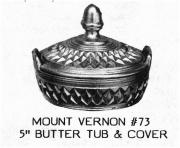 Another Cambridge pattern that included a butter dish is Mount
Vernon, a line introduced in 1931; and in the Fall of that year several
major trade journals were carrying advertisements for the Mount Vernon
pattern. The following caption appeared below a picture of the Mount
Vernon tall sherbet, goblet, cup & saucer and plate, superimposed
upon a picture of the original Mount Vernon, home of George
Washington."
Another Cambridge pattern that included a butter dish is Mount
Vernon, a line introduced in 1931; and in the Fall of that year several
major trade journals were carrying advertisements for the Mount Vernon
pattern. The following caption appeared below a picture of the Mount
Vernon tall sherbet, goblet, cup & saucer and plate, superimposed
upon a picture of the original Mount Vernon, home of George
Washington."
"MOUNT VERNON, This Early American pattern is a brilliant Crystal line by Cambridge. Inspired by worthy tradition and executed with true craftsmanship, it lends itself very naturally to the Early American dining room ensemble. Just a few items of the line are shown. Other items are footed tumbler, sugar and cream, bread and butter, fruit saucer, candy jar, footed bonbons, fancy comports, vases and bowls."
The following was extracted from a column titled "THE MAN WHO SAW," a regular feature that appeared in The Pottery, Glass & Brass Salesman. This particular item was taken from the January 28, 1932 issue.
"CAMBRIDGE GLASS COMPANY
"Mount Vernon" Pattern, an Early American
> Design, Done in Pressed GlassOne of the Patterns in the pressed glass line of the Cambridge Glass Company, of Cambridge, Ohio, which has recently been received by the various sales agents, including local representative Oliver C. Graham, 184 Fifth Avenue, is known as the "Mount Vernon." Here is an early American design, noteworthy for the faithfulness with which the original is copied, and, above all, for the brilliancy of its finish. Inspired by worthy traditions and executed with true craftsmanship, it lends itself naturally to the early American dining-room ensemble. It is obtainable in all of the Cambridge finest antique colors, including amber, royal blue, forest green and carmine, together with crystal.
The Mount Vernon butter dish was included among the original Cambridge catalog illustrations of the line, on pages issued in 1931 as a supplement to the 1930 catalog. Since a price list from those years has yet to become available to researchers, it is not known exactly how many of the colors cited in the Mount Vernon advertisement were used to produce the butter dish. In addition to those colors, other were also used in conjunction with Mount Vernon, the most notable being heatherbloom. Is there a heatherbloom Mount Vernon butter dish and cover? I really don't know, but butter dish collectors can certainly "wish upon a falling star."
The Mount Vernon line, to some extent, remained in the Cambridge line for many years, but the butter dish and cover was discontinued sometime during the 1940s, as is does not appear in the 1949 or later Cambridge catalogs and price lists.
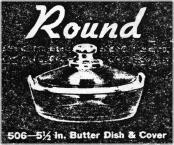 The #506 butter dish included in the 1940 Cambridge catalog as a
part of the Round Line, appears to have had its origins somewhat
earlier as a similar item is found in the Plainware line dating to the
1920s.
The #506 butter dish included in the 1940 Cambridge catalog as a
part of the Round Line, appears to have had its origins somewhat
earlier as a similar item is found in the Plainware line dating to the
1920s.
No precise date for the introduction of this #506 butter has been established, but it can be presumed it occurred at some point during the 1920s.
Made only crystal during the 1940s, there is nothing to preclude this item from having been made in any of the prevalent colors of the late 1920s and 1930s.
The #506 butter dish was very much a part of the Cambridge etched wares during the 1940s, being included in the Blossom Time, Chantilly, Diane, Portia, Elaine, Rose Point and Wildflower lines. Etching of this butter dish probably began during the 1930s, possibly as each of these etchings was introduced to the trade. It is possible other etchings as well as cuttings dating to the 1930s will be found on this butter dish.
Like so much of the wares produced in the 1920s, 1930s and 1940s, the #506 butter dish was discontinued during the mid-to-late 1940s when new lines and styles were introduced following the war.
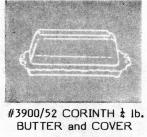 It wasn't until the final months of the original company's
operation in 1954 that molds to produce the quarter pound butter dishes
to the Caprice and Corinth lines were ordered. Whether or not they were
used prior to the plant closing in the summer of 1954 remains unknown,
but both molds were used during the reopen period (1956-58).
It wasn't until the final months of the original company's
operation in 1954 that molds to produce the quarter pound butter dishes
to the Caprice and Corinth lines were ordered. Whether or not they were
used prior to the plant closing in the summer of 1954 remains unknown,
but both molds were used during the reopen period (1956-58).
The #3900/52 Corinth line butter, produced in crystal only, was sold etched Rose Point, Wildflower and Chantilly, as well as plain. The final Cambridge price list, issued in 1958,offered the Corinth butter dish in any of these three etchings at a price of $51 a dozen.
(Editor's Note: We apologize for the poor quality of the Corinth butter dish; but our only available photo is the line drawing from the 1956-58 Catalog Reprint.)
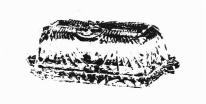 The Caprice quarter pound butter dish is somewhat scarce today,
indicating a limited production during the reopen years; even though it
remained in the Cambridge catalog until the final closing.
The Caprice quarter pound butter dish is somewhat scarce today,
indicating a limited production during the reopen years; even though it
remained in the Cambridge catalog until the final closing.
Available price lists from the reopen period state this piece was made in crystal only. However, the recent discovery of information indicating moonlight Caprice was produced to some extent during the reopen period, coupled with the existence of a moonlight Caprice butter dish (one that was seen several years prior to the current reuse of the Caprice molds), gives credence to the belief that at some point during the reopen period Cambridge did produce a "blue" Caprice butter dish.
Extreme caution should be exercised if offered such an item!! Know your dealer and the providence of the piece before buying!!
(EDITOR'S NOTE: An additional note on the Caprice butter dish. After the original sale of the Cambridge molds to the Imperial Glass Company, in the early 1960s, we know that Imperial produced glass from several of the Caprice molds. This production included the butter and cover. Imperial also produced a light blue color, very similar to moonlight, however, even though a few pieces of Caprice have been found which were made in this color, we do not have any proof that any of the butter dishes were included in the blue production. To our knowledge they produced the butter in crystal only.
Research has proven that it is nearly impossible to distinguish any difference between Cambridge and Imperial production of the crystal or moonlight in the Caprice pattern.)
